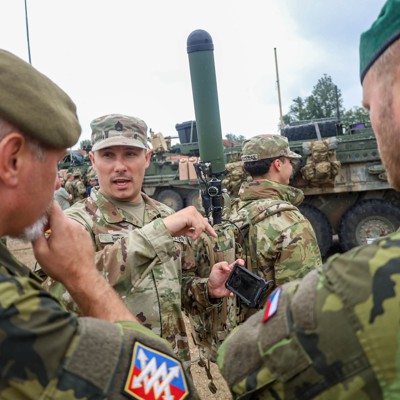The Army’s counterdrone mega-exercise in Europe isn’t over, but at least one thing seems clear: senior officers need more data training.
For the past five months, Project Flytrap has assembled U.S. soldiers and counterparts from Australia, Poland, and the United Kingdom to learn and improve on how to use counter unmanned aerial systems. Acquisition officials and industry representatives also joined the event, whose fourth phase wraps up on July 31. There are plans to add two more phases in fiscal year 2026.
Soldiers adapted quickly during the exercises, said Col. Donald Neal, who leads the 2nd Cavalry Regiment.
“We have years in the Middle East—fighting in Iraq and Afghanistan—where we had to learn to adapt to be survivable and lethal. I don’t think that’s changed,” Neal told reporters Wednesday. “We are learning rapidly how to incorporate drones into our [tactics, techniques and procedures] and the ways that we fight.”
Flytrap’s first three phases focused on identifying and testing counterdrone systems, incorporating them into existing platforms, such as ground vehicles, and practicing at the squad and platoon level. The fourth and final phase added operations at the company and battalion
level, included cUAS squads, and incorporated continuous defensive and offensive operations.
But the preliminary findings from the exercise indicate that senior leaders—lieutenant colonels and above—need training to manage the troves of data collected and detected in a drone-heavy battlefield, he said.
“Once you start talking O-5 levels, in and above, there probably is a need for folks that understand how to manage data and how to manipulate software. Because, when I talked earlier about the culture of adaptation, it is going to require a skill set that maybe we don’t have throughout our force in a very formal way. We owe that to the Army. We don’t know what that looks like yet, but that’s part of what we’re finding out in this project, this exercise, and feeding back up,” Neal said.
In the meantime, Neal said the unit is tapping younger soldiers and “looking past the MOS”—job classification—to find “hidden talents” to make the needed changes.
The Army has been racing to improve its drone training, formations, and expertise in recent years as the technology reshaped battles in Russia’s war on Ukraine.
Flytrap included about 40 organizations and 450 participants from industry. Participants used about 300 drones of at least 12 types to replicate real-world threats. The Army plans to introduce live fires to the exercise later this week.
“We made sure that those models represented each of the kind of capabilities that you’d expect to see on the modern battlefield. So, some had thermal optics for nighttime. We did have fiber-optic drones out here—so those are jam-resistant. We had larger drones, like group twos that are heavier…We had fixed wings,” said Col. Matthew Davis, V Corps chief technology officer and Flytrap’s director. “What we learned from using a diversified UAS threat is [that] it’s all the more reason for layering. If we flew the fiber optic at these, for example, the RF-detect systems that we were using—well, they weren’t going to detect them, so we had to rely on acoustics or an optical [sensor].”
The exercise revealed that certain tasks demand natural aptitude, said Command Sgt. Maj. Eric Bol, a senior enlisted leader of the 2nd Cavalry Regiment.
“Flying drones, we found, is definitely a skill set that some people have and some people don’t,” which is first assessed using simulators, Bol said. “Some people just have an aptitude for it, and we found that super helpful in our training process.”
But when it comes to countering drones, he said, “I think everybody’s picking it up at about the same rate. We’ve known, obviously, about this threat for some time now, and we’ve been trying to incorporate it into training for probably that entire period, and this is really the first time we’ve had technology that can assist that.”
Read the full article here








Leave a Reply